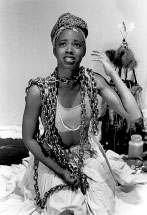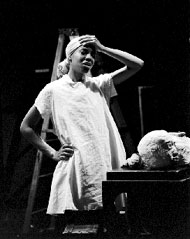

In the circle of life, people from history often come back to inspire us and teach us lessons. This weekend, senior Monique Askew pays tribute to two black women artists from the past, with her two act play, Sculptured Time. Askew wrote the play and is the solo performer.

Askew was drawn to the two women for their extraordinary stories, which she studied at the Schomburg Center for Research in Black Culture in Harlem. Edmonia Lewis was an Oberlin College student from 1859 and 1862. She was dismissed upon charges of poisoning two white female classmates. The charges were dropped due to insufficient evidence, and the speculation is that she was framed. She was bombarded with racial harrasment and was not permitted to return to Oberlin because of the stain attached to her name.
Determined not to be beaten down, she shook herself off and made an amazing turnaround. She became an internationally renowned sculptress, rubbing elbows with the likes of John Brown and William Lloyd Garrison and eventually setting up her own studio in Rome. It was sweet revenge in the face of the humiliation she experienced at Oberlin.
Augusta Savage was a Harlem Renaissance artist who experienced her peak in the 1920s/1930s. She was discovered as a gifted sculptress at an early age, and after studying in New York, she continued on in France, Belgium and Germany. Despite international exposure, she stayed devoted to her roots in Harlem, making it her mission to promote black artists. In 1932, she founded the Harlem School of Arts.
Askew found Savage to be particularly inspiring for her dedication to community activism in the arts. Despite her talent and fame, modesty was the characteristic that stuck out most. "She was very humble and very giving," said Askew, "and that's a quality you don't find very often these days." Savage, after a life of giving to others , died poor in relative obscurity.
The connections between the two women as black women pioneers in the field of art who suceeded on their own will and talent despite the odds are obvious, but Askew points out that it is the differences between them that provides the play's poignant lessons.
Lewis, who was actually half black and half Indian, was not very active in any kind of color community during her time at Oberlin and stuck mostly to whites. Yet it was the white community that turned on her in cold persecution. Savage, on the other hand, knew the importance of giving back to her community. Had they been peers, Lewis might have learned valuable lessons from Savage.
The set for the production is composed of an installation by senior art major, Prentiss Slaughter. One of the centerpieces of the set which is also seen in the poster design is a picture of an old Kongo cosmogram. It consists of a circle with a horizontal and verticle line running through it. The four points of the lines represent birth, life, death and rebirth in the circle of life. The bottom half of the circle represents the ancestors in the underworld. For Askew, it symbolizes the major themes that surround the production.

"I'm not just focusing on the art that they produced, but rather the struggle that produced the art, " said Askew. She explained that the cosmogram centers around a sense of the continuity of life and a connection to the earth, to family, to community and to ancestors. This was an idea embodied by Savage and an ethic that Askew herself echoes with this production.
Askew explained that "The installation is symbolizing a third character, which is an African woman who's coming into the space to reclaim her people and to tell them 'you are lost, let me remind you where you're from.'" The cycle that evolves is one of learning from history, remembering the sacrifices made and carrying on that spirit to do positive work in one's own time to create a better future.
With all the negative energy and cynicism that seems to pervade this campus these days, Askew was intent on making her final statement at this college a message of inspiration that would push students into remembering Oberlin as a community. "I want students to think about the way they treat each other," said Askew.
Although this project is clearly her pet, Askew was very insistent on giving credit to the community resources that helped make it possible. Herself an African-American Studies major, she found support to put this production on from many sources including Theater and Dance, the Art Department and the President's office. Faculty advisors on the production included African Studies lecturer Adenike Sharpley, Professor of Art Johnny Coleman and Artist in Residence Michael Early.
Augusta Savage: "Sculptured Time" will be performed tonight at 8 p.m. in Little Theater and Saturday, May 2 at 2 p.m. Tickets are $2 OCID, $3 others. All tickets are half off with donation of canned or boxed food.
The Struggle (top): Monique Askew recalls the injustice experienced by her artistic ancestors (photo by John Seyfried)
A woman and her work (bottom): Senior Monique Askew pays tribute to two black women artists, Augusta Savage and Edmonia Lewis, in her two act play, Sculptured Time. (photo by Laren Rusin)
Copyright © 1998, The Oberlin Review.
Volume 126, Number 23, May 1, 1998
Contact us with your comments and suggestions.